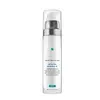What's inside
What's inside
 Key Ingredients
Key Ingredients

 Benefits
Benefits

 Concerns
Concerns

 Ingredients Side-by-side
Ingredients Side-by-side

Water
Skin ConditioningGluconolactone
Skin ConditioningCyclopentasiloxane
EmollientLactobionic Acid
BufferingPropylene Glycol
HumectantEthylhexyl Hydroxystearate
EmollientCyclohexasiloxane
EmollientTriethanolamine
BufferingLimnanthes Alba Seed Oil
Skin ConditioningGlycerin
HumectantArginine
MaskingC12-15 Alkyl Ethylhexanoate
EmollientGlycol Distearate
EmollientOctyldodecyl Myristate
EmollientStearyl Alcohol
EmollientPEG-100 Stearate
Glyceryl Stearate
EmollientEthoxydiglycol
HumectantHydrogenated Vegetable Oil
EmollientPetrolatum
EmollientDimethicone
EmollientAlgae Extract
EmollientHydrogenated Lecithin
EmulsifyingPhosphatidylcholine
EmulsifyingSodium Hyaluronate
HumectantPalmitic Acid
EmollientStearic Acid
CleansingMyristic Acid
CleansingSteareth-2
EmulsifyingCaprylic/Capric/Myristic/Stearic Triglyceride
EmollientHydroxyethylcellulose
Emulsion StabilisingXanthan Gum
EmulsifyingPolyacrylamide
C13-14 Isoparaffin
EmollientLaureth-7
EmulsifyingCaprylyl Glycol
EmollientDisodium EDTA
Sodium Sulfite
PreservativeSodium Bisulfite
AntioxidantPhenoxyethanol
PreservativeChlorphenesin
AntimicrobialCI 19140
Cosmetic ColorantCI 17200
Cosmetic ColorantWater, Gluconolactone, Cyclopentasiloxane, Lactobionic Acid, Propylene Glycol, Ethylhexyl Hydroxystearate, Cyclohexasiloxane, Triethanolamine, Limnanthes Alba Seed Oil, Glycerin, Arginine, C12-15 Alkyl Ethylhexanoate, Glycol Distearate, Octyldodecyl Myristate, Stearyl Alcohol, PEG-100 Stearate, Glyceryl Stearate, Ethoxydiglycol, Hydrogenated Vegetable Oil, Petrolatum, Dimethicone, Algae Extract, Hydrogenated Lecithin, Phosphatidylcholine, Sodium Hyaluronate, Palmitic Acid, Stearic Acid, Myristic Acid, Steareth-2, Caprylic/Capric/Myristic/Stearic Triglyceride, Hydroxyethylcellulose, Xanthan Gum, Polyacrylamide, C13-14 Isoparaffin, Laureth-7, Caprylyl Glycol, Disodium EDTA, Sodium Sulfite, Sodium Bisulfite, Phenoxyethanol, Chlorphenesin, CI 19140, CI 17200
Water
Skin ConditioningGlycerin
HumectantDimethicone
EmollientNiacinamide
SmoothingPropanediol
SolventDimethicone/PEG-10/15 Crosspolymer
Methylsilanol/Silicate Crosspolymer
Skin ConditioningSodium Chloride
MaskingPolymethylsilsesquioxane
Phenoxyethanol
PreservativeMicrocrystalline Cellulose
AbsorbentCI 77163
Cosmetic ColorantChlorphenesin
AntimicrobialCaprylyl Glycol
EmollientSodium Citrate
BufferingEthylhexyl Hydroxystearate
EmollientPEG-10 Dimethicone
Skin ConditioningDisodium EDTA
Cellulose Gum
Emulsion StabilisingLaminaria Digitata Extract
Skin ProtectingAdenosine
Skin ConditioningCitrus Aurantium Amara Flower Oil
MaskingMelaleuca Viridiflora Leaf Oil
Skin ConditioningTetradecyl Aminobutyroylvalylaminobutyric Urea Trifluoroacetate
Skin ConditioningLinalool
PerfumingCymbopogon Flexuosus Oil
MaskingCitral
PerfumingLimonene
PerfumingPelargonium Graveolens Flower Oil
MaskingWater, Glycerin, Dimethicone, Niacinamide, Propanediol, Dimethicone/PEG-10/15 Crosspolymer, Methylsilanol/Silicate Crosspolymer, Sodium Chloride, Polymethylsilsesquioxane, Phenoxyethanol, Microcrystalline Cellulose, CI 77163, Chlorphenesin, Caprylyl Glycol, Sodium Citrate, Ethylhexyl Hydroxystearate, PEG-10 Dimethicone, Disodium EDTA, Cellulose Gum, Laminaria Digitata Extract, Adenosine, Citrus Aurantium Amara Flower Oil, Melaleuca Viridiflora Leaf Oil, Tetradecyl Aminobutyroylvalylaminobutyric Urea Trifluoroacetate, Linalool, Cymbopogon Flexuosus Oil, Citral, Limonene, Pelargonium Graveolens Flower Oil
 Reviews
Reviews

Ingredients Explained
These ingredients are found in both products.
Ingredients higher up in an ingredient list are typically present in a larger amount.
Caprylyl Glycol is a humectant and emollient, meaning it attracts and preserves moisture.
It is a common ingredient in many products, especially those designed to hydrate skin. The primary benefits are retaining moisture, skin softening, and promoting a healthy skin barrier.
Though Caprylyl Glycol is an alcohol derived from fatty acids, it is not the kind that can dry out skin.
This ingredient is also used as a preservative to extend the life of products. It has slight antimicrobial properties.
Learn more about Caprylyl GlycolChlorphenesin is a synthetic preservative. It helps protect a product against bacteria in order to extend shelf life. In most cases, Chlorphenesin is paired with other preservatives such as phenoxyethanol and caprylyl glycol.
Chlorphenesin is a biocide. This means it is able to help fight the microorganisms on our skin. It is also able to fight odor-releasing bacteria.
Chlorphenesin is soluble in both water and glycerin.
Studies show Chlorphenesin is easily absorbed by our skin. You should speak with a skincare professional if you have concerns about using Chlorphenesin.
Learn more about ChlorphenesinDimethicone is a type of synthetic silicone created from natural materials such as quartz.
What it does:
Dimethicone comes in different viscosities:
Depending on the viscosity, dimethicone has different properties.
Ingredients lists don't always show which type is used, so we recommend reaching out to the brand if you have questions about the viscosity.
This ingredient is unlikely to cause irritation because it does not get absorbed into skin. However, people with silicone allergies should be careful about using this ingredient.
Note: Dimethicone may contribute to pilling. This is because it is not oil or water soluble, so pilling may occur when layered with products. When mixed with heavy oils in a formula, the outcome is also quite greasy.
Learn more about DimethiconeDisodium EDTA plays a role in making products more stable by aiding other preservatives.
It is a chelating agent, meaning it neutralizes metal ions that may be found in a product.
Disodium EDTA is a salt of edetic acid and is found to be safe in cosmetic ingredients.
Learn more about Disodium EDTAEthylhexyl Hydroxystearate isn't fungal acne safe.
Glycerin is already naturally found in your skin. It helps moisturize and protect your skin.
A study from 2016 found glycerin to be more effective as a humectant than AHAs and hyaluronic acid.
As a humectant, it helps the skin stay hydrated by pulling moisture to your skin. The low molecular weight of glycerin allows it to pull moisture into the deeper layers of your skin.
Hydrated skin improves your skin barrier; Your skin barrier helps protect against irritants and bacteria.
Glycerin has also been found to have antimicrobial and antiviral properties. Due to these properties, glycerin is often used in wound and burn treatments.
In cosmetics, glycerin is usually derived from plants such as soybean or palm. However, it can also be sourced from animals, such as tallow or animal fat.
This ingredient is organic, colorless, odorless, and non-toxic.
Glycerin is the name for this ingredient in American English. British English uses Glycerol/Glycerine.
Learn more about GlycerinPhenoxyethanol is a preservative that has germicide, antimicrobial, and aromatic properties. Studies show that phenoxyethanol can prevent microbial growth. By itself, it has a scent that is similar to that of a rose.
It's often used in formulations along with Caprylyl Glycol to preserve the shelf life of products.
Water. It's the most common cosmetic ingredient of all. You'll usually see it at the top of ingredient lists, meaning that it makes up the largest part of the product.
So why is it so popular? Water most often acts as a solvent - this means that it helps dissolve other ingredients into the formulation.
You'll also recognize water as that liquid we all need to stay alive. If you see this, drink a glass of water. Stay hydrated!
Learn more about Water